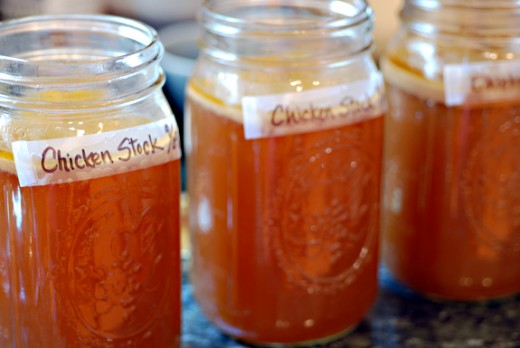Chicken Stock - Stock Making 101

Eventually I may get somewhat close to being able to tell you all the reasons that homemade stocks are worth making. May get close. The reasons frankly are too many to list. Think of it as the difference between canned spaghetti and your granny's homemade marinara with meatballs and real parmigiana.
Trust me when I say that once you've made the first three batches and seen the results in your cooking then you'll be hooked. So this is my blatant attempt to lure you into addiction to stock. You'll thank me for it. And not only is it a socially acceptable addiction, both your budget and your dishes will be grateful. You'll use it everywhere - sauces and gravies of course, but soups, stews, vegetable prep and braising...this is a workhorse in the kitchen. On top of everything else - this basic stock is not only super easy, but it's pretty much a free bonus with Roasted Chicken. See? Lovies all around!
Now classical technique calls for a multitude of different stocks - and none of them are this one. A traditional chicken stock is in one of two categories - white (or blonde stock) and brown stock. You can use these for different applications - if you want a delicate soup or butter sauce - you'd use blonde stock. If you want a heartier dish with stronger, richer flavors, then you'll want a brown stock. The main difference in these two is whether the chicken and bones are roasted ahead of time. The caramelization accompanying roasting has beautiful effects.
We're going to make this stock by stealing method from traditional stockmacking, and then shortcutting the fire out of it. I will certainly outline the methods for those techniques in their entirety soon - because they are NOT difficult, despite their reputations as high maintenance, and the results are frankly glorious. Classic technique is classic for a reason - and stocks are a great example of how good food can be elevated to miraculous.
However I would consider those to be Stocks 201. The only reason they are 201 classes instead of Stock 101 is because there are ideas that can be introduced earlier. Not even complex ideas. What I want to give you is Stock 101 - Introduction to Stock Making. The great thing about this is that what you'll get something out of it that will revolutionize your cooking - even if you never go beyond this class. Give yourself three times through this method and you'll see just where a great stock can take you.
Ready to rock? Let's go!
The Method!
Ok - first off - this is 100% method - please understand that before anything else! I cannot - and will not - give you a recipe. Stock making is method - which if fabulous. But the best part is you don't need a recipe! Once you understand the method - you're completely free to do your stock as you want. I will explain why in just a moment.
I'll give you a shortcut rundown of the method in bullet form at the end of the article - but I really believe if you know WHY things happen, you'll be able to make things happen on your own when you want.
Start off with the carcass from a Roast Chicken. Whenever I roast one chicken, I'll usually just go ahead and do two. That jump starts me at least two extra meals in advance. Even if I use the extra meat for only one more dish (and I usually get two more out of it), I also have glorious stock to use as the base of another meal. For example, I will roast two chickens, and serve one as the center of a meal on it's own. (See Basic Brine for Poultry). I go ahead and 'pick' the carcasses - remove all the meat from the bones. I use the meat however I want - Boonie's Mile High Big Chicken Pot Pie, Chicken Pot Pie with Cream Cheese Biscuits, Quick Asian Chicken Salad, quesadillas, any casserole you can think of - even sliced for fabulous sandwiches. If your chickens were big (and I usually get the biggest ones I can find) you'll get at least two additional meals depending on how many you feed. The some of stock I make is used as the base for a meal on it's own, a hearty soup or stew like Chicken Love for Leigh, Chicken and Dumplings, or a risotto or grits such as Mushroom Parmesan Risotto or Creamy Cheese Grits Primavera. See? You have acres of applications for this stuff!
So - put your chicken carcass - all of it - into a stock pot and cover it with water. If you have a 'real' stock pot with a pasta insert great. You really want to use a pot that is taller than it is wide - a narrower pot is better. You want to minimize the rate of evaporation of your liquid. However, since this particular stock is not going to cook for 8-10 hours - it's really not that big a deal. The important thing is to keep all the ingredients covered with cold water. So your vessel really needs to simply be large enough to hold all the 'stuff' - bones, skin, any vegetables you roasted with it (but not citrus - discard that), and the 'goop' off the bottom of the roasting pan.
So - everybody into the pool - cover with cold water, and bring to a simmer. While more 'refined' stocks are never, never boiled, frankly I've walked away and boiled the fire out of half the basic stock I've ever made. I'm still allowed in polite society. Ideally, you want to only have the barest simmer - this keeps the taste of the stock cleaner because the fat is not emulsified into the stock itself by the movement of a boil that's too hard - instead staying seperate and floating to the top.
Once the stock has begun to simmer, skim off the scummy stuff that floats to the top. You'll see it - it's foamy and kind of a pale dirty brown. Skim it off with a spoon and discard it. Again - the world won't end if you don't get every speck, but take sixty seconds and get most of it.
Some people will tell you to go ahead and skim the fat off the top. In Stocks 201 you will probably do this - but in this stock I don't think there's any need. You added water - which is key to this. Water will dilute and remove all the fabulous flavors from the chicken and vegetables. It will then concentrate them as it cooks. It will also separate your fat for you if you let it. I'd let it. I'm all for a technique that will do the work for you.
That's it - allow it to simmer for anywhere from an hour to four hours. If you want to you make it even more low maintenance, put the whole pot in a 200F oven and walk away. Whichever you choose - oven or stovetop - just give it a peek every once in a while to ensure that the ingredients are still completely submerged. If you've lost volume due to skimming or evaporation, just add a little more water to make up the difference and continue to simmer.
Once you have hit the minimum hour (and I've even skimped to 45 minutes if I had a high chicken to water ratio), then you're ready to strain and store. Line a fine wire mesh strainer with cheesecloth, a clean nap-free washcloth or a clean cotton handkerchief. I like the reusable, washable options - they're cheaper and more readily available than cheesecloth. And for this they work really well. Just make sure you get 100% cotton, and that you don't have anything with a 'nap' that will separate and end up in your food. That's not luscious.
Place your strainer over a clean container, and pour your stock through, removing the large pieces of chicken bones and veggies. Discard all of that - it's worked hard for you. Let it go to it's eternal reward in peace. Say thank you and goodbye.
At this point - it's ready to use. You can run it through a fat separator if you wish - I usually do. But I also have a tendancy to be unable to find mine. My six year old likes to play with it as a construction scene accessory. It's doesn't matter - this is a great example of letting the kitchen science work for you. Because oil and water don't mix, the fat will rise to the top of the broth. Once it's chilled, it will solidify, and you can literally just lift it off.
Now - you'll notice that your broth is a rich, deep golden brown. That's perfect. Remember that color means flavor - try doing a side by side comparison with canned chicken broth or stock. You'll be amazed. I promise!
One last note - unlike most of my instructions, I don't say salt and reseason to taste. A couple of things here - you would have had seasonings in the roast chicken carcass you started with, especially if you had brined your bird before you roasted it. Yes, the water with which you made your stock will have diluted that a good bit, but you also spent at least forty five minutes to an hour concentrating those flavors. So be very careful there - you want your stock to taste underseasoned at this point. When you move to your next application, to use it in sauce or soup or a braise, you'll season then. Your broth will be far better if the seasonings are layered in - during the brine, then the roasting, then during the long simmer, and finally when you finish your final dish. That layering of seasonings means a depth and complexity of flavor you cannot get any other way.
Quick Recap
- Place carcass and any roasted vegetables in a stockpot with the juices from the roasting pan.
- Cover carcass and all vegetables with cold water, and bring pot to a simmer. Don't boil - just a bare simmer.
- Reduce heat to maintain the gentlest simmer possible. Skim the froathy foam from the top.
- Allow pot to simmer for one to four hours, making sure to add water if necessary to keep the bones and vegetables covered.
- Remove from heat. Strain and store in the fridge. Easy peasy!
- The Thrillbilly Gourmet
Applying classic technique to everyday food for spectacular results!








